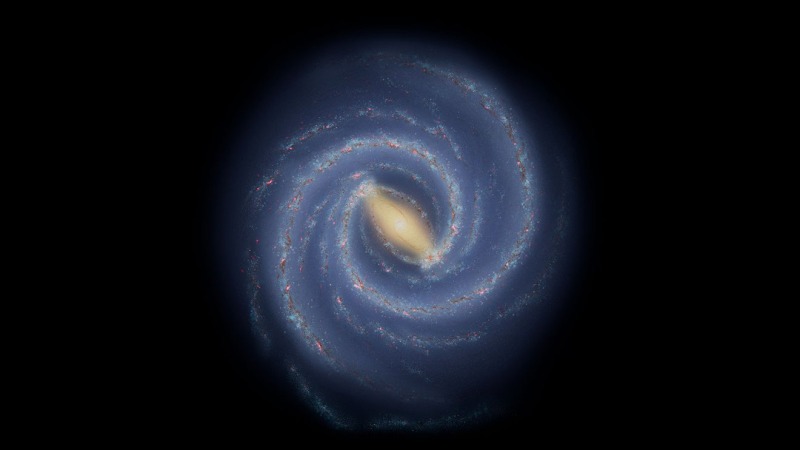The Milky Way's outer reaches may have lumpy, choppy arms
The new model presents a contrast to the traditional long, sleek arms presented in images of our galaxy.

We may need to check our assumptions about how the Milky Way looks to an outsider.
While the typical artist's image of our galaxy suggests a barred spiral with long, graceful arms, the challenge is that we made these interpretations from data collected from within the galaxy, which provides a poor view of its outer reaches.
New work from the Hubble Space Telescope, based on measuring distances to cosmic objects, shows at least part of the outer arms may be clumpier and stubbier than believed. That said, predictions suggesting a lumpier set of arms at the galaxy's outer edge were made as far back as 1971, the research team said.
"It's a good possibility that the outer disk of the Milky Way resembles the nearby galaxy Messier 83, with shorter, chopped-up pieces of arms," Josh Peek, an associate astronomer at the Space Telescope Science Institute (STScI) in Baltimore, said in a statement.
Related: The best Hubble Space Telescope images of all time!

Peek and his colleagues focused on studying the Perseus spiral arm of the Milky Way. Mapping our galaxy typically involves trying to measure distances to different objects.
Scientists can use masers, which are naturally occurring radio sources that happen in regions with a lot of massive stars being formed. But as masers aren't everywhere, scientists often need to use other techniques to approximate galactic-scale distances.
Breaking space news, the latest updates on rocket launches, skywatching events and more!
Another step would be to try using the motions of those gas clouds, but the challenge is trying to predict those motions based on imperfect information. Ideally, NASA said in the statement, the motion measured for a gas cloud is "directly related to its distance due to the overall rotation of the Milky Way," allowing scientists to determine the galaxy's structure.
The new study asked what would happen if a gas cloud might also have random motions, which the research team measured using dust as a proxy. (That's because where you see gas, you usually see dust.) Generating the three-dimensional dust maps required looking at the colors of groups of stars all over the sky. Stars with a lot of dust in between themselves and the telescope will appear redder compared to their natural color, NASA said.
Hubble's data indeed showed more complexity to the Perseus arm than believed. The dust cloud observations showed that, opposite to what other studies assumed, the clouds don't lie at the distance of the Perseus arm (roughly 6,000 light-years away). Instead, the clouds move out to a distance of roughly 10,000 light-years.
But now the team would like to focus their efforts on the inner Milky Way as well, to get a better sense of how the galaxy is shaped as a whole. Hubble fellow Catherine Zucker, a member of Peek’s team at STScI, plans to use 3D dust maps using infrared observations of one billion to two billion stars reddened by dust.
"By linking those new dust maps with existing gas velocity surveys, astronomers can refine our map of the inner Milky Way much as they have already done with the outer galaxy," NASA stated, noting that more information may come from other observatories if the team's study ideas are accepted for telescope time.
The Nancy Grace Roman Space Telescope is expected to be able to map the entire plane of the galaxy in a few hundred hours, using infrared light to see through the dust (and perhaps view the other side of the Milky Way for the first time). Additionally, the Vera Rubin Observatory can examine faint, faraway observations in several wavelengths, which when combined with Roman would provide robust distances to other objects.
A study based on the new research was accepted for publication in the Astrophysical Journal.
Follow Elizabeth Howell on Twitter @howellspace. Follow us on Twitter @Spacedotcom or on Facebook.

Elizabeth Howell (she/her), Ph.D., was a staff writer in the spaceflight channel between 2022 and 2024 specializing in Canadian space news. She was contributing writer for Space.com for 10 years from 2012 to 2024. Elizabeth's reporting includes multiple exclusives with the White House, leading world coverage about a lost-and-found space tomato on the International Space Station, witnessing five human spaceflight launches on two continents, flying parabolic, working inside a spacesuit, and participating in a simulated Mars mission. Her latest book, "Why Am I Taller?" (ECW Press, 2022) is co-written with astronaut Dave Williams.
